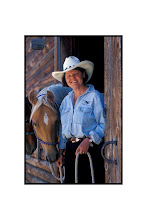Irrigating in Drought Years
We appreciate Rascal-dog and his antics. He comes on high at the first sound of the 4-wheeler. He believes it is his job to chase the birds and clear the way down the lane and over to the pasture where we are flood irrigating. By the time we get there he is frothing at the mouth from excitement and saliva plasters on his face and neck. He makes a beeline across the set leaving a rooster tail of water in his wake.
While it is not a matter of public record, we choose to believe our forefathers all had dogs with personality. The first generation came trailing thousands of cattle Lonesome-Dove-style from Texas and settling on creeks that are named after them. Reportedly the first to plant alfalfa in the county, our great grandparents had aspirations for sustainable agriculture. Generations that followed have split up and also added to the ranch to make room for their sons and daughters.
Now we are the ones continually watching the level of snow pack in the Crazy Mountains. A good water right is the life blood of a good ranch, irrigating not only pasture but also hay the lands. A water right filed in 1908 doesn’t even count. All of the first rights were filed in the 1800s. First in right, first in time. That’s why the lowest on the creek drainage usually has the first right because it was settled first. And the first permanent settler in Sweet Grass County made his stand on Duck Creek. In the late 1800’s the early settlers dug irrigation ditches by hand and by horse. It took diligence and persistence and knowledge. You have to admire them for their willingness to do the back breaking work.
Even now a lot of what we do in Montana summers is get ready for Montana winters. We hope to get one spring irrigation on pastures before we put the water on the hayfields. Some of the land is not really intended to be irrigated--never leveled or cultivated--but the native grasses really respond to water. Yielding early spring feed for the calves (before they go to the mountains for the summer,) and with any luck, fall pasture for the sheep after the lambs are weaned.
The focus is now on the alfalfa fields. With limited spring run off, the May “high water” mark in the creek was already down to what we would normally see in August . The wheel lines are operational but the seal is broken on the filter for the center pivot. Rick is trying to get it running but things don’t always match up--have to go back for parts. Lots of mainline to put together. Time is money and every drop of water counts.
Mother Nature and politics are beyond our control and it is wreaking havoc on our state of mind. It is hard to put a brave face on the drought this many years in to it. Depending on where we live in Montana we are facing the 5th, 6th, or even 7th year of drought. It is like Mother Nature turned her back on us after the hundred-year floods of 96 and 97. Some Montana counties have already been designated emergency drought areas due to below normal precipitation. It kinda takes the starch out of you--that and the volatility in the cattle market due to mad cow disease. Will the borders be open or closed? Will Japan allow us to export? There is so much beyond our control that it is making ranchers afraid to make decisions about selling or buying cattle and about stocking rates in general.
Rick’s usually happy go-lucky character is pretty darn serious these days. After years of problem solving his way through ranching, he says he is losing his starch. It will be a wicked fire season if this low moisture continues, not to mention what the lack of irrigation water will mean. He states simply, “Know the road, but don’t see the end.”
